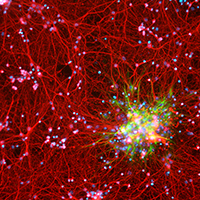Quantitative, structural and molecular changes in neuroglia of aging mammals: A review

Accepted: 27 May 2021
HTML: 11
All claims expressed in this article are solely those of the authors and do not necessarily represent those of their affiliated organizations, or those of the publisher, the editors and the reviewers. Any product that may be evaluated in this article or claim that may be made by its manufacturer is not guaranteed or endorsed by the publisher.
Authors
The neuroglia of the central and peripheral nervous systems undergo numerous changes during normal aging. Astrocytes become hypertrophic and accumulate intermediate filaments. Oligodendrocytes and Schwann cells undergo alterations that are often accompanied by degenerative changes to the myelin sheath. In microglia, proliferation in response to injury, motility of cell processes, ability to migrate to sites of neural injury, and phagocytic and autophagic capabilities are reduced. In sensory ganglia, the number and extent of gaps between perineuronal satellite cells – that leave the surfaces of sensory ganglion neurons directly exposed to basal lamina– increase significantly. The molecular profiles of neuroglia also change in old age, which, in view of the interactions between neurons and neuroglia, have negative consequences for important physiological processes in the nervous system. Since neuroglia actively participate in numerous nervous system processes, it is likely that not only neurons but also neuroglia will prove to be useful targets for interventions to prevent, reverse or slow the behavioral changes and cognitive decline that often accompany senescence.
How to Cite
PAGEPress has chosen to apply the Creative Commons Attribution NonCommercial 4.0 International License (CC BY-NC 4.0) to all manuscripts to be published.
Similar Articles
- Y. Kaneko, N. Onda, Y. Watanabe, M. Shibutani, Identification of 5-hydroxytryptamine-producing cells by detection of fluorescence in paraffin-embedded tissue sections , European Journal of Histochemistry: Vol. 60 No. 3 (2016)
- J. Suchánková, S. Legartová, P. Sehnalová, S. Kozubek, S. Valente, D. Labella, A. Mai, C. Eckerich, F.O. Fackelmayer, D.V. Sorokin, E. Bartova, PRMT1 arginine methyltransferase accumulates in cytoplasmic bodies that respond to selective inhibition and DNA damage , European Journal of Histochemistry: Vol. 58 No. 2 (2014)
- Zhongli Shi, Wayne K. Greene, Philip K. Nicholls, Dailun Hu, Janina E.E. Tirnitz-Parker, Qionglan Yuan, Changfu Yin, Bin Ma, Immunofluorescent characterization of non-myelinating Schwann cells and their interactions with immune cells in mouse mesenteric lymph node , European Journal of Histochemistry: Vol. 61 No. 3 (2017)
- Mariko Kawai, Yu-Ki Ohmori, Mai Nishino, Masayo Yoshida, Kaori Tabata, Do-Saku Hirota, Ayako Ryu-Mon, Hiromitsu Yamamoto, Junya Sonobe, Yo-Hei Kataoka, Noriko Shiotsu, Mika Ikegame, Hiroki Maruyama, Toshio Yamamoto, Kazuhisa Bessho, Kiyoshi Ohura, Determination of cell fate in skeletal muscle following BMP gene transfer by in vivo electroporation , European Journal of Histochemistry: Vol. 61 No. 2 (2017)
- L.V. Renna, R. Cardani, A. Botta, G. Rossi, B. Fossati, E. Costa, G. Meola, Premature senescence in primary muscle cultures of myotonic dystrophy type 2 is not associated with p16 induction , European Journal of Histochemistry: Vol. 58 No. 4 (2014)
- A. Makowiecka, A. Simiczyjew, D. Nowak, A.J. Mazur, Varying effects of EGF, HGF and TGFβ on formation of invadopodia and invasiveness of melanoma cell lines of different origin , European Journal of Histochemistry: Vol. 60 No. 4 (2016)
- D. Nowak, A. J. Mazur, A. Popow-Woźniak, A. Radwańska, H. G. Mannherz, M. Malicka-Błaszkiewicz, Subcellular distribution and expression of cofilin and ezrin in human colon adenocarcinoma cell lines with different metastatic potential , European Journal of Histochemistry: Vol. 54 No. 2 (2010)
- Kentaro Nishida, Saho Bansho, Akiko Ikukawa, Teruyo Kubota, Akihiro Ohishi, Kazuki Nagasawa, Expression profile of the zinc transporter ZnT3 in taste cells of rat circumvallate papillae and its role in zinc release, a potential mechanism for taste stimulation , European Journal of Histochemistry: Vol. 66 No. 4 (2022)
- E. De Nevi, P. Marco-Salazar, D. Fondevila, E. Blasco, L. Pérez, M. Pumarola, Immunohistochemical study of doublecortin and nucleostemin in canine brain , European Journal of Histochemistry: Vol. 57 No. 1 (2013)
- Alimu Keremu, Pazila Aila, Aikebaier Tusun , Maimaitiaili Abulikemu, Xiaoguang Zou, Extracellular vesicles from bone mesenchymal stem cells transport microRNA-206 into osteosarcoma cells and target NRSN2 to block the ERK1/2-Bcl-xL signaling pathway , European Journal of Histochemistry: Vol. 66 No. 3 (2022)
<< < 1 2 3 4 5 6 7 8 9 10 > >>
You may also start an advanced similarity search for this article.

 https://doi.org/10.4081/ejh.2021.3249
https://doi.org/10.4081/ejh.2021.3249










